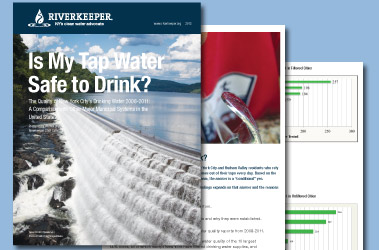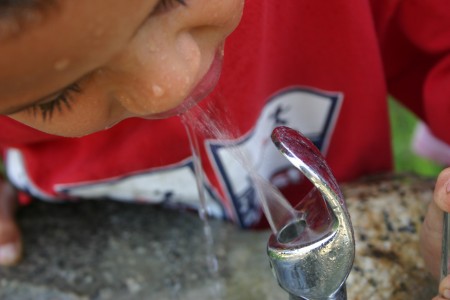Is My Tap Water Safe to Drink?

View more images on our Flickr site
Working with Riverkeeper’s Watershed Team, I have often been asked by residents of New York City and the Lower Hudson Valley—people who depend on New York City’s drinking water supply—whether their tap water is safe to drink.  To answer this question with some facts and numbers to support it, I decided to conduct some research comparing the quality of New York City’s drinking water to the quality of the 10 largest U.S. cities, all of which except New York filter their drinking water. I also compared New York City’s water quality to that of four other large U.S. cities that rely on unfiltered drinking water supplies. What my research showed is that the quality of New York City’s water remains high and yes, it is safe to drink, but there are some threats and challenges ahead. Our findings and conclusions are presented in Is My Tap Water Safe to Drink – The Quality of New York City’s Drinking Water 2008-2011.
To answer this question with some facts and numbers to support it, I decided to conduct some research comparing the quality of New York City’s drinking water to the quality of the 10 largest U.S. cities, all of which except New York filter their drinking water. I also compared New York City’s water quality to that of four other large U.S. cities that rely on unfiltered drinking water supplies. What my research showed is that the quality of New York City’s water remains high and yes, it is safe to drink, but there are some threats and challenges ahead. Our findings and conclusions are presented in Is My Tap Water Safe to Drink – The Quality of New York City’s Drinking Water 2008-2011.
After analyzing the annual drinking water quality reports of all of the surveyed cities over a four-year period, several key findings emerged from the data I collected:
- New York City’s testing program is robust and comprehensive and overall drinking water quality in the cities surveyed is very high. In all four years reviewed, the City tested drinking water for more contaminants than any of the 10 largest U.S. cities surveyed.
- Lead contamination, which is caused by lead-soldered plumbing in older buildings, remains a concern at the tap. Over the four-year study period, New York reported the highest average number of samples that exceeded drinking water standards for lead. However, lead can be flushed from household plumbing systems by running tap water for 30 seconds.
- New York City reported extremely low levels of waterborne pathogens in approximately 80% of the water samples tested. Although the City’s testing methods did not allow the City to determine whether detected organisms were alive or capable of causing disease, no waterborne disease outbreaks were reported. However, the presence of any potentially disease-causing organisms in drinking water supplies is of concern particularly to upstate communities that receive water from the Catskill/Delaware system that has not been treated by the City’s UV disinfection facility in Westchester County.
- Some of New York City’s reservoirs exceeded drinking water limits for turbidity on a number of occasions during the study period. Turbidity is caused by sediment that remains suspended in surface waters. Turbidity in drinking water supplies can mask the presence of pathogens and inhibit chlorine disinfection. If turbidity is not adequately mitigated in the near future, storm-driven increases in reservoir turbidity could require expensive filtration of the City’s drinking water.
- New York City detected pharmaceuticals and personal care products (PPCPs), contaminants of emerging concern, in its water supply. After confirming the presence of trace concentrations of some PPCPs in 2010, New York discontinued its PPCP testing program in 2011. Virtually all PPCPs are contaminants for which there are no state or federal standards. No long-term studies exist to determine their potential risks to human health, but many have documented adverse effects on aquatic organisms.
Based on the concerns we identified, we recommended actions that the City needs to take now in order to protect this precious resource. I believe that our recommendations will enhance the protection of New York City’s drinking water supplies now and into the future. The cost of not putting solutions in place to combat these very real threats is far too great to ignore.
- Resume New York City’s PPCP testing program. We also urge New York State and the federal government to develop regulatory standards for PPCPs in municipal drinking water supplies.
- Require retrofitting of lead-soldered plumbing in households reporting lead exceedances.
- Maintain and if necessary, enhance source controls to reduce or eliminate waterborne pathogens in upstream and terminal reservoirs.
- Implement sound turbidity control measures to protect New York City’s reservoirs, delivery system and consumers from the risk of pathogens and a potential, expensive filtration mandate.

